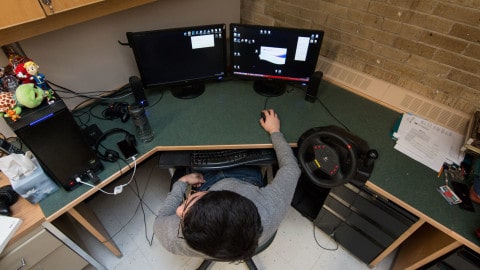In a world where technology is continually and rapidly advancing, the Human-Computer Interaction Lab, a research facility at the University of Saskatchewan in the department of computer science, is seeking to navigate and understand the ever-changing relationship between humans and technology.
The Interaction Lab researches everything from computer games to next generation interfaces, such as 3-D displays. New technology, particularly computer games, is becoming increasingly popular. Most people spend more on video games than on music and movies combined.
According to the Entertainment Software Association of Canada, 19 million Canadians are gamers, comprising 54 per cent of the population.
Regan Mandryk, associate professor of computer science and senior faculty at the Interaction Lab, specializes in research and development of video games.
“It’s not just the stereotypical young teenage boy in his basement playing Call of Duty anymore. There’s more female gamers over the age of 50 than there are boys under the age of 16 … the demographics have changed completely. The average gamer is in their mid-thirties and people of all ages play,” Mandryk said.
The Interaction Lab is not only a space for experienced researchers like Mandryk, but also presents many opportunities for undergraduate and graduate students at the U of S.
Professors provide students with an enriched learning experience by bringing cutting-edge research from the lab into the classroom. In addition, the Interaction Lab hires undergraduate interns each summer and provides a critical mass of researchers and peers for graduate students.
each summer and provides a critical mass of researchers and peers for graduate students.
“We offer a chance for undergraduate students to actually build up their CV in computer science, practice the skills that they are learning and be exposed to research all in one go,” Mandryk said.
Human-computer interaction is the most important part of computer science for Mandryk.
“Computer science offers a lot of opportunities for problem solving, for analytic thinking and also for creative thinking,” she said. “For me, it’s the touchy-feely side of computer science. It’s bringing in the human element to our use of technology.”
Mandryk has specifically studied the effects of social exclusion in multi-player computer games. She also tests and develops exer-games, video games that include exercise, to increase physical fitness, conducting studies with children, university students and the elderly.
“I think there are two main ways that we can leverage the motivational power of games to increase exercise. One is by integrating exercise into the game itself,” she said. “The other way to do it would be to give people game-based rewards for exercising [out of game].”
By studying the integrated exercise option with a graduate student, Mandryk has discovered real benefits of exer-games.
“[Exer-games are] just as good as exercising on a treadmill in terms of the cardiovascular benefits and the target heart rate that people reached,” she said.
Dylan Fafard, a fourth-year undergraduate student in computer science, began working at the Interaction Lab in September as a project for a research course for honours students.
Fafard works in the lab to create software for 3-D displays, such as a five-sided cube, which will be used primarily in a medical setting. He expects that this technology will be ready for use within the next five years and says that 3-D displays will be used alongside the 2-D imaging that medical professionals already work with.
“I think it would be used in conjunction, you know, just throw in a scan into the 3-D display and see it and maybe you could determine, ‘Hey, I actually want to look at this area a little bit more in detail,’ and you could put that on a regular screen,” Fafard said.
These displays function with a headset, body tracking tools such as Microsoft Connect, or wireless technology, the most accurate method.
Fafard especially appreciates how he can apply the math that he learned in high school and university to his work within the Interaction Lab.
“I definitely enjoy getting to solve problems and kind of see my work unfold right in front of me.”
Mandryk shares Fafard’s enthusiasm, insisting that video games have positive benefits and that they can “satisfy the basic needs of humans, whether that be good health or relatedness with others or feeling like [we’re] mastering challenges.”
—
Jessica Klaassen-Wright
Photo: Caitlin Taylor / Photo Editor